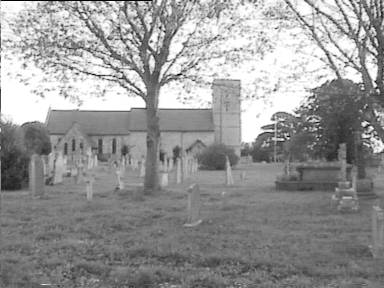![]()

![]()
34. St Andrew, Hamble-le-Rice

This wonderful Norman church was founded between 1109 and 1128 by Benedictine monks from Thiron near Chartres. The great Norman nave and tower remains virtually unaltered though the chancel was rebuilt in 1250. The name "Le Rice" means "the Rise", the church being built on land 50 feet above sea level. In 1377 during the Hundred Years War French raiders burned and plundered the priory into ruin and the church itself was damaged. In 1391 William of Wykeham founder of Winchester College used stones from the ruins to repair the church and tower.
The main door of the church is a Norman arch with zig-zag mouldings protected by a 15th century porch. The interior with its very high nave is most impressive. A window half way up the west tower lets in ample light through its glass, plain except for the stained glass head of St Andrew. Beautiful brass candlesticks, once part of an eighteenth century chandelier, are placed all along the walls of the nave. At the eastern end of the nave Norman doors mark the end of the people's church and the beginning of the monastic choir.
The stained glass and most of the church fittings are Victorian. The East Window is of plain glass except for the central figure of St Andrew holding a ship in one arm, a staff in the other and with a fish at his feet, as well as a picture of the church mostly in yellow and blue. Outside through the plain glass one can see the waving branches and leaves of the trees in the churchyard.
In the side chapel is a window depicting St Cecilia, patron of music, holding some pipes. In the north wall of the nave two more windows show Noah and his Ark, and Isaiah appearing before Hezekiah (Isaiah 38v.5-10). A more recent window depicts the badge of the Training Ship Mercury. This was a training ship moored nearby on the Hamble from 1885 which trained over 5,000 boys for the R.N. and Merchant Navy until its closure in 1968. C. B. Fry the famous England cricketer was Commandant for many years.
The walls of the nave are covered in memorials many of naval origin. For example there is Baptist Douglas, Quarter Master of His Majesty's 96 Regiment of Foot, who expired on 7 September 1811 on his passage home from the West Indies after serving King and Country for two and twenty years, aged 39. Also the brothers James and Bonamy Broadby, both naval captains who died 'of the fatal yellow fever in Martinique' in 1795 and 1801. One interesting modern memorial is to Sir Edwin Elliott Verdon-Roe O.B.E. the first Englishman to fly, and his two sons both killed in 1941 whilst flying in the R.A.F.
Last but not least is the church's latest acquisition dating from 1994. This is a large and impressive tapestry made by the ladies of the parish which traces the history of the church. Various scenes show the arrival of the monks by sea, the building of the church in Caen stone, the burning by the pirates in 1377, the Training Ship Mercury, searchlights and bombers from World War II, harvest scenes, yachts, the font, candles burning on the High Altar, the church choir, a wedding and so on. The tapestry hangs on the wall just to the right of the entrance door and adds much to the beauty of the church.
Outside, the great cedar tree beyond the tower overshadows the large churchyard. All in all a fine Norman building which has much to offer the visitor.
John Symonds
![]() Return to the Christmas & New Year 1999/2000 Features
page
Return to the Christmas & New Year 1999/2000 Features
page
![]() return to Home page and main index
return to Home page and main index
page last updated 5 DECEMBER 1999